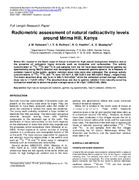| dc.contributor.author | Kebwaro, Jeremiah Monari | |
| dc.contributor.author | Rathore, I.V.S. | |
| dc.contributor.author | Hashim, N.O. | |
| dc.contributor.author | Mustapha, A.O. | |
| dc.date.accessioned | 2015-10-13T06:36:32Z | |
| dc.date.available | 2015-10-13T06:36:32Z | |
| dc.date.issued | 2011-07 | |
| dc.identifier.uri | http://karuspace.karu.ac.ke/handle/20.500.12092/1969 | |
| dc.description.abstract | Mrima Hill, located in the South coast of Kenya is known for high natural background radiation, due to the presence of radiogenic heavy minerals such as monazites and carbonatites. The activity concentration of 238U, 232Th and 40K in soil samples from the hill have been determined by gamma ray spectrometry using NaI(Tl) detector and decomposition of measured gamma-spectra. As a measure of radiation hazard to the public, gamma radiation dose rates were also estimated. The average activity concentrations of 238U, 232Th and 40K were 207.0±11.3, 500.7±20.0 and 805.4±20.0 Bqkg-1, respectively. The mean absorbed dose rate in air is 440.7±16.8 nGyh-1 while the estimated annual average effective dose rate is 1.11±0.01 mSvy-1. The absorbed dose rate due to gamma radiation from naturally occurring radioactive materials is above the global average value of 60 nGyh-1 (UNSCEAR, 2000) | en_US |
| dc.language.iso | en | en_US |
| dc.publisher | International Journal of the Physical Sciences | en_US |
| dc.subject | High natural background radiation, gamma ray spectrometry, NaI(Tl) detector, Mrima Hill | en_US |
| dc.title | Radiometric assessment of natural radioactivity levels around Mrima Hill, Kenya | en_US |
| dc.type | Article | en_US |
